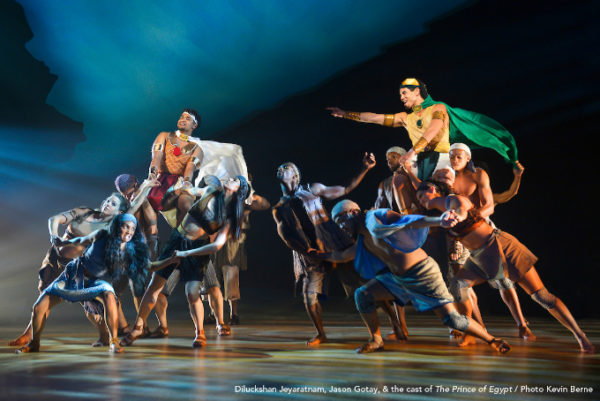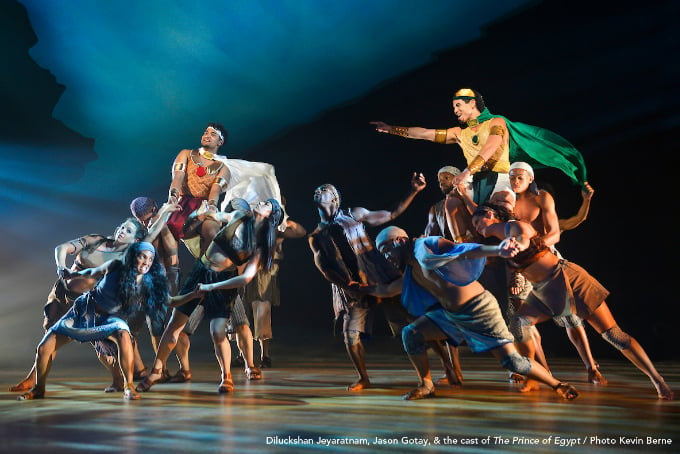
In his reimagining of the 1998 DreamWorks film, director Scott Schwartz’s “The Prince of Egypt” is a touching and captivating retelling of the Book of Exodus. While live musical theatre cannot convey some of the same expansiveness and mysticism of animation film, the production, staged by TheatreWorks in the Mountain View Center for the Performing Arts, makes a valiant effort through its technical elements and produces an overall inspiring and enjoyable show.
The musical is a fairly straightforward adaptation of the film. In a loose interpretation of the Book of Exodus, “The Prince of Egypt” follows Moses, a Hebrew raised as Egyptian royalty, as he realizes his true identity and grows apart from his newly crowned brother, Ramses. After summoning the 10 plagues upon Egypt, Moses leads the Hebrews from enslavement, through the Red Sea and toward the promised land. While songs such as “Footprints on the Sand” and “One of Us” were recently created for the musical, classics like “Deliver Us” and “Through Heaven’s Eyes” are readapted from the film.
Designed by Kevin Depinet, the set resembles a cutout of the dusty desert: A meandering platform that covers half the stage diagonally and tilts up at the back almost dune-like. Its outline is mirrored by a ceiling panel that resembles a swooping cloud hanging above center stage; the ceiling piece spans the other diagonal and dramatically curves up closer to the audience, forming a smooth, vertical side for projections. Unlike the floor piece, which grows In the middle of the floor is a small sand pit, and while it was not utilized nearly enough, the haze it creates at the start of the show further establishes the story’s epic tone. The rooms and buildings that appear throughout the show are comprised almost entirely by an array of moveable sandstone blocks. During transitions, the ensemble moves swiftly with impressive coordination to create a set arrangement – some like Moses and Ramses’ secret room are creative, some like the outside of a pyramid are unconvincing.
The fairly minimalistic set creates the opportunity for amazing projection and lighting design. Shawn Sagady’s projections encompass both the floor and ceiling set pieces to aid in establishing the scene – a hint of the limitless universe of animation. A bright sun beats down on Moses in the desert, and the sand dunes below him dance in the invisible wind. Deep green, blue and purple lights swirl the stage during Moses’ dramatic, mystic scenes, particularly when Moses encounters the burning bush. Carefully twisting and swaying, the ensemble forms and acts as the tree as lighting designer Mike Billings casts an eerie violet backlight on the figure.
Much of the show’s impact, however, would not be without the ensemble and choreographer Sean Cheesman. Maintaining incredible form and consistency throughout the entire show, the ensemble, whether as Hebrews, Midianites or the landscape itself, demonstrate their prowess with deceptive ease, often forming complex clusters to act as mobile set pieces. For example, Moses and Ramses race each other on a galloping chariot of ensemble members, while later in the show, these same people balance and contort upon each other as the intimidating burning bush.
Moses and Ramses, played by Diluckshan Jeyaratnam and Jason Gotay respectively, are a powerful duo in both acting and singing. The two begin as energetic and outgoing, racing through city markets and teasing each other. As they grow older and assume their separate roles in society – Moses as a Hebrew in exile and Rameses as pharaoh – Jeyaratnam and Gotay become unwillingly cold and vengeful, pitted against each other by tradition and faith. While their emotional arcs are hindered at times by cheesy dialogue and ill-fitting costumes, the two show off their impressive vocal range in “I Will Make It Right/No Power on Earth.”
As Tzipporah – a Midianite girl who escaped enslavement in the Pharaoh’s palace – Brennyn Lark is a powerful and commanding presence onstage. Her voice resonates throughout the theater during “Dance to the Day” as she dances and stares down Moses with utter conviction. As time goes on, Lark presents a skillful control of her emotional range, revealing her caring and humorous side as Tzipporah and Moses begin their relationship. Similarly, Christina Sajous as Queen Tuya is also a compelling and multifaceted figure in the show. She is a headstrong yet tender mother, easily alternating between comforting toward her two sons and argumentative with her politically minded husband, Pharaoh Seti (Tom Nelis).
A surprisingly notable performance comes from David Crane as Aaron, Moses’ Hebrew brother. Although he initially seems to be a minor character, Crane adds an unexpected yet hilarious streak of comedy in the show with his sarcastic tone and exaggerated gesticulations. In “One of Us,” he and the Hebrew ensemble welcome and warn Moses of the not-so-comfortable life of being Jewish — a sentiment often familiar for a Jewish audience. Crane, however, demonstrates his depth in the song’s reprise, his composure now a serious, contained anger after Moses accidently doubles the Hebrews’ workload.
Paul-Jordan Jansen as Jethro, Midianite high priest and Tzipporah’s father, also displays incredible talent in his feature role. As a warm, fatherly foil to Pharaoh Seti, Jansen moves with a joyous lightness that contrasts his rich, deep singing voice. “Through Heaven’s Eyes” is inspiring and chills-inducing as Jansen dances with Moses and Tzipporah across the stage, instructing them and the audience to look up into the endless, starry sky.
The musical adaptation of “The Prince of Egypt” is, overall, a delightful show with an exuberant cast and an innovative crew. The Exodus story itself is a powerful reminder of human perseverance, even if this world premiere showing has its flaws. Although the show is not groundbreaking and likely will not change the face of modern theater, it is still a show worth seeing.
“The Prince of Egypt” ran until Nov. 5 in the Mountain View Center for the Performing Arts.
Contact Julia Gordon at jmgordon ‘at’ stanford.edu.
